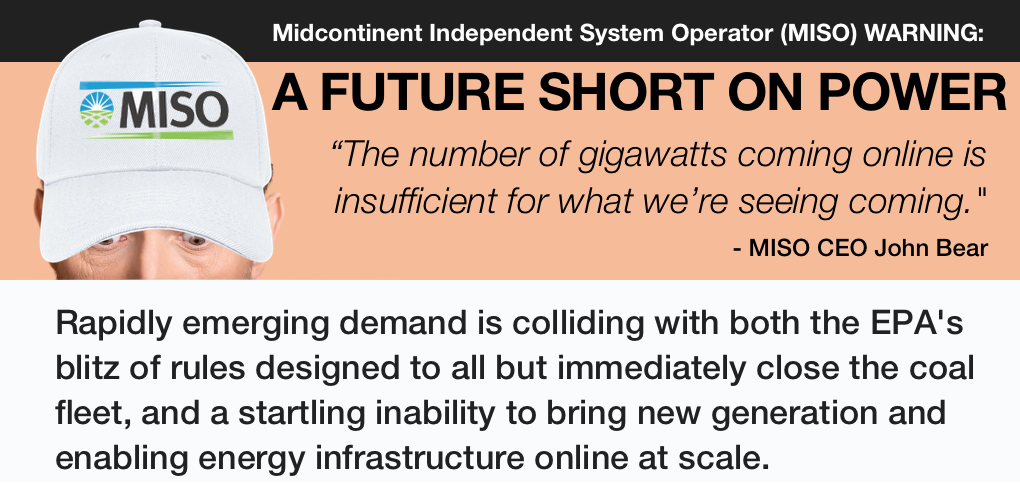
MISO Warns it’s Going to be Woefully Short of Power
Across the country, one grid operator after another is sounding the alarm over soaring power demand, an inability to meet it and the threat posed by early retirements of essential coal capacity.
PJM Interconnection, the Southwest Power Pool (SPP), the Electric Reliability Council of Texas and now the Midcontinent Independent System Operator (MISO) have all plainly and forcefully warned they are going to be short of power in the years ahead.
Surging power demand from electrification, the explosive growth of data centers and the reshoring of heavy industry has upended the power demand picture nearly overnight. This rapidly emerging demand is colliding with both the U.S. Environmental Protection Agency’s (EPA) blitz of rules designed to all but immediately close the coal fleet, and a startling inability to bring new generation and enabling energy infrastructure online at scale.
Consider the latest warning from MISO. In June, MISO said that if its members don’t delay retirements of power plants or bring more resources online faster and at larger numbers than they have historically, a potential 2.7-gigawatt deficit next year could soar to 14 GW in 2029. A deficit of that size is equivalent to being short the power needed for 10 million homes.
MISO CEO John Bear plainly warned that “the number of gigawatts coming online is insufficient for what we’re seeing coming.” He added, “We’ve got a lot of work to do to slow down the retirements and speed up the additions coming onto the system.”
MISO has 50 GW of new generating capacity, mostly intermittent renewables, across 316 projects that have been approved for connection but are experiencing delays in construction. This missing capacity is an enormous problem. But even if this capacity can be added – a huge if – Bear has warned it doesn’t offer the same reliability attributes of what is being lost with baseload generation continuing to fall off the system.
With Demand Exploding, a Need for Better Modelling
MISO now expects anywhere from 12 GW to 14 GW of demand growth in coming years from data centers alone. MISO Senior Vice President and Chief Customer Officer Todd Hillman said, “that would be like adding 11 million homes. And these have much higher capacity factors than homes. That’s just a gigantic addition to a grid that’s already stressed.” He added that “poor visibility into the magnitude and timing of large load additions is putting at risk our ability to reliably accommodate them.”
So rapid and so large is this growth, coupled with electrification and resurgent industrial investment, MISO is now warning it needs to change its modelling for future demand. In other words, the approach MISO is currently using based on historical experiences simply isn’t up to the task at hand.
The Choir of Concern Grows Louder
MISO’s dire warnings are just the latest voice added to a choir of concern. In May, PJM warned that EPA’s blitz of rules are incompatible with surging power demand.
PJM said, “We are seeing vastly increased demand as a result of new data center load, electrification of vehicles and increased electric heating load. The future demand for electricity cannot be met simply through renewables given their intermittent nature,” PJM wrote in its statement.
PJM added in reference to the so-called Clean Power Plan 2.0, “yet in the very years when we are projecting significant increases in the demand for electricity, the Final Rule may work to drive premature retirement of coal units that provide essential reliability services.”
SPP issued a similarly forceful warning about the impact of the Clean Power Plan 2.0. “SPP remains concerned, however, about the impact the Final Rule may have on the region’s ability to maintain resource adequacy and ensure reliability in the SPP region…. If sufficient flexible thermal resources are not available to play their critical roles in SPP’s resource mix, SPP’s ability to maintain regional reliability will be directly impacted.”
The operator added, “SPP is not expressing these concerns about a hypothetical resource adequacy scenario in the future. SPP and other grid operators are currently working to develop planning and operations policies and practices to deal with resource adequacy issues that have already manifested.”
As MISO, PJM and SPP have made abundantly clear, the challenges and shortfalls they’re facing aren’t theoretical—they’re here. They need every tool they can get their hands on to maintain reliability and meet surging new demand. The tools they seem to need most are the essential baseload power plants they have today that EPA is determined won’t be there tomorrow.
- On July 10, 2024
